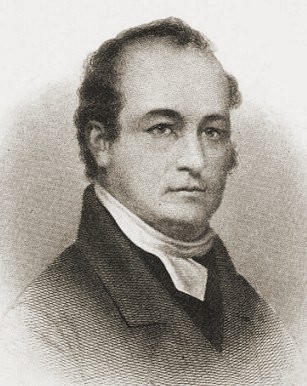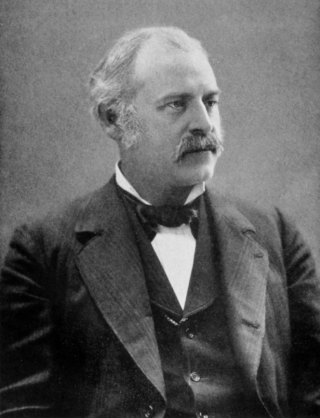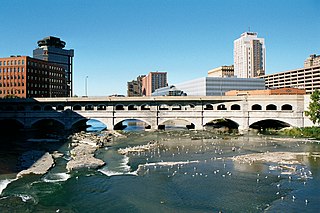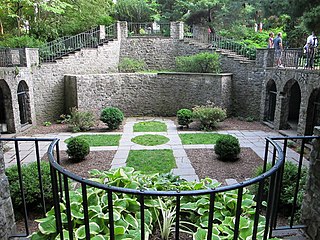
Mount Auburn Cemetery, located in Cambridge and Watertown, Massachusetts, is the first rural or garden cemetery in the United States. It is the burial site of many prominent Boston Brahmins, and is a National Historic Landmark.

Myron Holley was an American politician who played a major role in the creation of the Erie Canal. In 1816, he was appointed to the five-person Erie Canal Commission, which had the task of organizing and supervising the canal's construction. As one of two full-time and salaried members of the commission, he was its treasurer and the supervisor for the construction of the canal's main route.

The Main Street Historic District in Medina, New York, United States, is the downtown commercial core of the village. It is a 12-acre (4.9 ha) area stretching south along Main Street from the Erie Canal to the railroad tracks.

Cobblestone architecture refers to the use of cobblestones embedded in mortar as method for erecting walls on houses and commercial buildings. It was frequently used in the northeastern United States and upper Midwest in the early 19th century; the greatest concentration of surviving cobblestone buildings is in New York State, generally near the historic Erie Canal or connecting canals.

Lowertown Historic District is a national historic district located at Lockport in Niagara County, New York. The district is predominantly residential in nature, with some commercial structures and warehouses. The mose elegant homes are along Market Street, east of Chapel Street, facing the Erie Canal. Notable structures in this district include the Western Block Company Warehouse, a 2+1⁄2-story stone structure built before 1855; Lockport Bank Building built in 1829, and located at 315-319 Market Street; Washington Hunt House, built in 1831 and home to New York Governor Washington Hunt, and located at 363 Market Street; the former Christ Episcopal Church at 425 Market Street; and the Vine Street School, an Italianate style one-room school built in 1864.

The Orleans County Courthouse Historic District is one of two located in downtown Albion, New York, United States. Centered on Courthouse Square, it includes many significant buildings in the village, such as its post office and churches from seven different denominations, one of which is the tallest structure in the county. Many buildings are the work of local architect William V.N. Barlow, with contributions from Solon Spencer Beman and Andrew Jackson Warner. They run the range of architectural styles from the era in which the district developed, from Federal to Colonial Revival.

Hervey Ely House, also known as the Daughters of the American Revolution Chapter House, is a historic home located at Rochester in Monroe County, New York.

First Presbyterian Church is a historic Presbyterian church located at Rochester in Monroe County, New York. It is a Gothic Revival–style edifice designed in 1871 by Rochester architect Andrew Jackson Warner. It is built of Albion sandstone and trimmed with white Medina sandstone. It features a single stone bell tower and spire at the northeast corner beside the main entrance. It was the third home for Rochester's oldest congregation. It is now home to the Central Church of Christ.

Andrew Jackson Warner, also known as A. J. Warner, was a prominent architect in Rochester, New York.

Whiteside, Barnett and Co. Agricultural Works, also known as Canal-Front Warehouse, is a historic factory and warehouse complex located at Brockport in Monroe County, New York. It is a largely intact and rare surviving example of the brownstone industrial building that once lined the banks of the Erie Canal at Brockport. It is also the only surviving building related to the local reaper manufacturing industry. The existing buildings were built between 1850 and 1852 for the Agricultural Works in Brockport, later known as Whiteside, Barnett and Co. The property was later used as a lumberyard from about 1880 to 1904 and as a cannery until 1945.

Phoenix Building, also known as the Phoenix Hotel or Pittsford Inn, is a historic inn and tavern located at Pittsford in Monroe County, New York. It is a Federal style structure built around 1820 to serve stage passengers. It later served passengers along the Erie Canal. The building operated as a hotel until the 1950s.

Rochester Savings Bank is a historic bank building located at Rochester in Monroe County, New York. It is a four-story, "V" shaped structure, sheathed in Kato stone from Minnesota. It was designed by McKim, Mead and White and built in 1927 to house the Rochester Savings Bank. The building's banking room interior features murals painted by noted artist Ezra Winter.

Bevier Memorial Building is a historic institutional building built originally for the Rochester Athaneaum and Mechanics Institute located at Rochester in Monroe County, New York. It is a three and a half brick story with ceramic trim designed by Claude Fayette Bragdon and completed in 1910.

Erie Canal: Second Genesee Aqueduct, also known as the Broad Street Aqueduct or Broad Street Bridge, is a historic stone aqueduct located at Rochester in Monroe County, New York. It was constructed in 1836–1842 and originally carried the Erie Canal over the Genesee River. The overall length of the aqueduct including the wings and abutments is 800 feet (240 m). The aqueduct is 70 feet (21 m) wide and has large parapets on either side. It is one of four major aqueducts in the mid-19th century Erie Canal system. In 1927, a roadbed was added to carry automobile traffic and named Broad Street. It also carried a part of the Rochester Subway.

Rochester City Hall is a historic government building in Rochester in Monroe County, New York. Also known as the Federal Building and Old Post Office, the building was originally built for use by the federal government. It is a four-story, Richardsonian Romanesque style structure with an inner court and tower. It was built between 1885 and 1889 of heavy brown sandstone with a metal skeleton. It was expanded in 1893 and in 1907. The building was designed in part by architect Harvey Ellis under the Office of the Supervising Architect Mifflin E. Bell. The building has served as the City Hall since the 1970s. It was listed on the National Register of Historic Places in 1972.

Powers Building is a historic office building located in Rochester in Monroe County, New York. It was built in 1869 and is a nine-story, 165-by-171-foot building, laid out around a large open stairwell in the center. It features a triple mansard roof and observation tower which were added after initial construction, between 1873 and 1888, by Daniel Powers to maintain its standing as the tallest building in Rochester. It was designed by noted Rochester architect Andrew Jackson Warner.

Brown's Race Historic District is a national historic district located at Rochester in Monroe County, New York. The district contains 15 contributing buildings, 2 contributing structures, and 14 contributing sites. All of the principal buildings are used for commercial purposes and are sited along or near the curving south rim of the Genesee River gorge at the rim of the High Falls. The district comprises a collection of 19th-century industrial buildings built of brick and stone, and ranging in size from one- to six-stories. Also in the district is the mill race and the 19th century iron Pont De Rennes bridge, which is used today as a pedestrian bridge and viewing platform of the High Falls and surrounding gorge.

Mt. Hope–Highland Historic District is a national historic district located at Rochester in Monroe County, New York. Its encompassed by the neighborhoods of Mount Hope and Highland Park. It has a diverse range of architectural styles. The district was the exclusive domain of the Ellwanger and Barry Botanic Gardens and Mt. Hope Cemetery throughout the mid- and late-19th century. It retains its elegant and spacious character of park land.

This is intended to be a complete list of properties and districts listed on the National Register of Historic Places in Rochester, New York, United States. The locations of National Register properties and districts may be seen in an online map by clicking on "Map of all coordinates".

Black River Canal Warehouse is a historic canal warehouse building located at Boonville in Oneida County, New York. It was built in 1850 and is a 1+1⁄2-story, rectangular, wood-frame building, 28 feet by 40 feet with a gable roof. It was built as a warehouse on the Black River Canal and used as such until the canal was abandoned in 1924.
























